Located in Chihuahua, Mexico, the Naica Cave is home to one of the most extraordinary natural phenomena in the world — massive selenite crystals. Discovered in 2000, this incredible cave lies 300 meters underground and is filled with transparent crystals that can grow up to 12 meters in length and weigh as much as 55 tons. These crystals are the result of hundreds of thousands of years of growth under very specific conditions. Let’s explore ancient civilization with archeology.dulichvn.net.
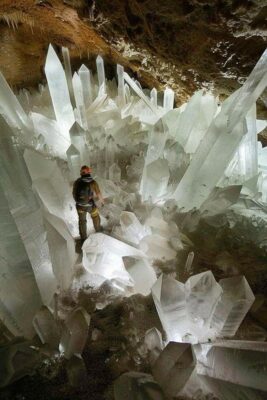
The Giant Crystals of Naica Cave
Structure and Size of Selenite Crystals
Naica Cave is famous for its giant selenite crystals, some of the largest known natural crystals in the world. These stunning formations are not only visually captivating but also represent the long, slow process of crystallization that took place under unique natural conditions over centuries.
Conditions That Fostered Giant Crystals
The formation of these giant selenite crystals in Naica Cave is closely linked to its high temperatures (45-50°C) and mineral-rich underground water. This warm environment created ideal conditions for dissolved gypsum in the water to gradually crystallize, forming the enormous selenite crystals we see today.
The Story Behind Their Formation
These giant selenite crystals didn’t form by chance. They are the result of a geological process that has taken place over millions of years. The slow crystallization of gypsum in the cave water represents the dynamic and ever-changing forces at work beneath the Earth’s surface.
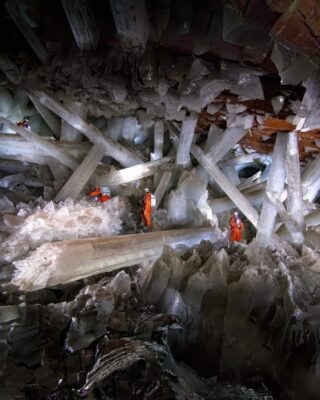
Naica Cave: A Geological Marvel
Extreme Temperatures and Humidity in the Cave
One of the most striking features of Naica Cave is the extreme temperatures and humidity it holds. The cave maintains temperatures of 45-50°C and nearly 100% humidity, creating a uniquely harsh environment that has allowed the crystals to grow while making the cave almost impossible to explore.
Exploration and Discovery of the Cave
Since the discovery of Naica Cave in 2000, researchers and explorers have ventured into its depths to study the structure and formation of the giant crystals. However, the dangerous conditions, including extreme heat and humidity, make it an incredibly challenging environment for exploration.
The Impact of Opening the Cave for Exploration
When the cave was first opened for exploration, the sudden change in air temperature disrupted the growth of the crystals, causing them to stop growing. This interruption has led to a unique phenomenon where the crystals have been frozen in time, offering an intriguing glimpse into the natural processes that shaped them.
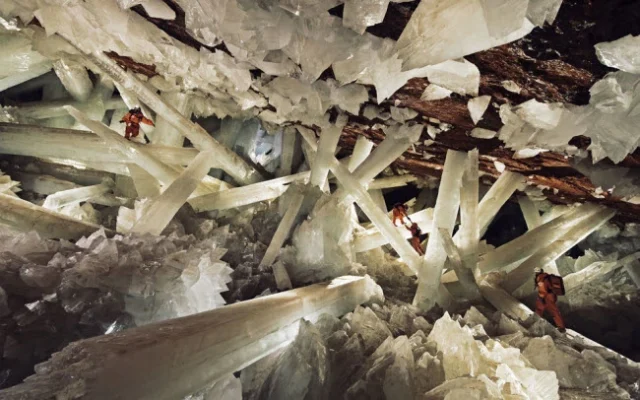
Selenite Crystals and Geological Processes Beneath the Earth
The Formation Process of Selenite Crystals
The selenite crystals in Naica Cave are the product of a slow crystallization process that has occurred over thousands, if not millions, of years. Dissolved gypsum in the cave’s underground water gradually crystallized, forming the massive structures that are now visible in the cave.
The Role of the Cave’s Special Environment
Naica Cave’s unique environment, with its high temperature and rich mineral water, created conditions that are rarely seen elsewhere in the world. The gypsum-rich underground water played a crucial role in the development of these giant crystals, making Naica Cave a rare geological wonder.
How the Giant Crystals Were Formed
The formation of these giant selenite crystals is a slow and deliberate process. Each crystal grew over time, with layer upon layer of gypsum slowly crystallizing and forming the gigantic structures that now fill the cave.
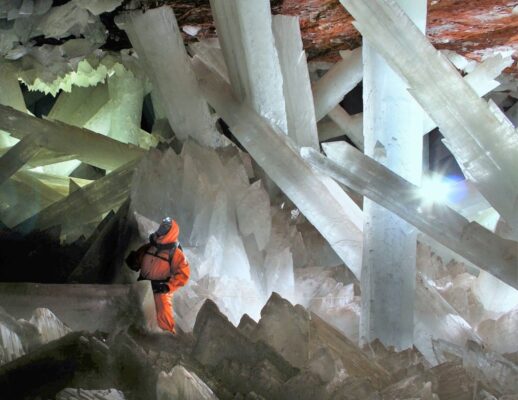
Naica Cave: A Restricted Yet Valuable Discovery
Why Access to Naica Cave Is Restricted
Due to its extreme conditions, access to Naica Cave is highly restricted. Only scientists and explorers equipped with specialized gear can venture into the cave. The high temperatures and humidity make it a dangerous place for anyone unprepared to handle such extreme environments.
The Challenges of Exploring the Cave
Entering Naica Cave is not for the faint of heart. To explore its depths, researchers need protective gear, including heat-resistant suits and air filtration systems. These challenges make Naica Cave one of the most difficult and dangerous places to explore, adding to its allure as a scientific treasure.
Conservation Efforts for Naica Cave
Local authorities and conservation groups have worked hard to protect Naica Cave from the potential negative impacts of human exploration. Limiting access and ensuring that the site is only visited under strict supervision has been key in preserving both the crystals and the delicate environment of the cave.
See more: The Antiochos Grandeur World’s Largest Intact Mosaic
Conclusion: A Rare Geological Wonder
Naica Cave, with its enormous selenite crystals, stands as one of the most extraordinary natural wonders on Earth. The process that created these giant crystals is a testament to the powerful geological forces working beneath the Earth’s surface. Although exploration remains difficult, the cave remains a fascinating window into nature’s ability to create stunning, otherworldly structures. Naica Cave is a must-see for those interested in geology, natural wonders, and the mysteries that lie beneath the Earth’s surface.

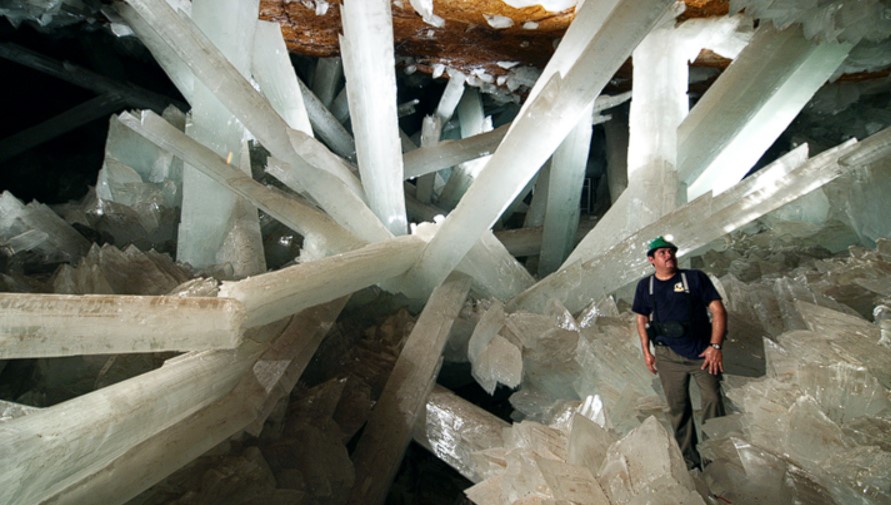
CÁC TIN KHÁC
Mark Twain & Olivia Langdon: A 36-Year Love Story Filled with Laughter and Devotion
The Tollund Man: A 2,400-Year-Old Mystery Preserved in a Danish Bog
Skara Brae: Scotland’s Hidden Neolithic Village
Porta Nigra: The Hidden Depths of Trier’s Iconic Roman Gate